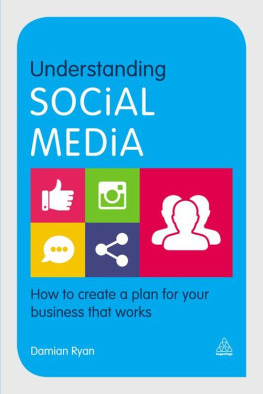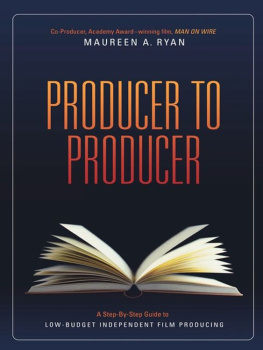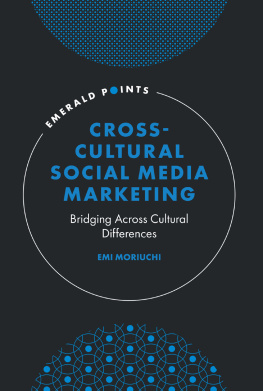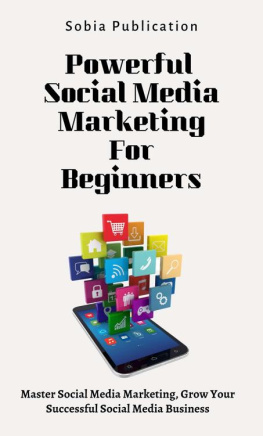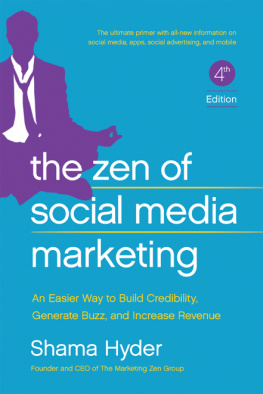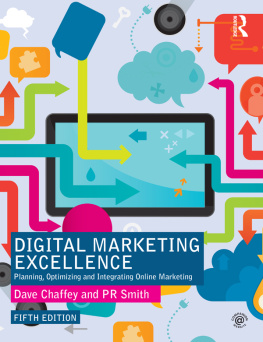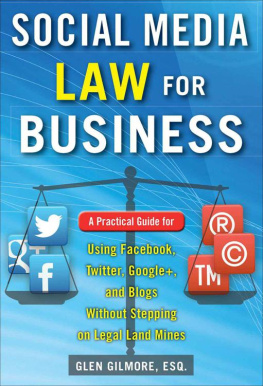Ryan - Understanding Social Media : How to Create a Plan for Your Business that Works
Here you can read online Ryan - Understanding Social Media : How to Create a Plan for Your Business that Works full text of the book (entire story) in english for free. Download pdf and epub, get meaning, cover and reviews about this ebook. City: London, year: 2015, publisher: Kogan Page, genre: Politics. Description of the work, (preface) as well as reviews are available. Best literature library LitArk.com created for fans of good reading and offers a wide selection of genres:
Romance novel
Science fiction
Adventure
Detective
Science
History
Home and family
Prose
Art
Politics
Computer
Non-fiction
Religion
Business
Children
Humor
Choose a favorite category and find really read worthwhile books. Enjoy immersion in the world of imagination, feel the emotions of the characters or learn something new for yourself, make an fascinating discovery.
Understanding Social Media : How to Create a Plan for Your Business that Works: summary, description and annotation
We offer to read an annotation, description, summary or preface (depends on what the author of the book "Understanding Social Media : How to Create a Plan for Your Business that Works" wrote himself). If you haven't found the necessary information about the book — write in the comments, we will try to find it.
Ryan: author's other books
Who wrote Understanding Social Media : How to Create a Plan for Your Business that Works? Find out the surname, the name of the author of the book and a list of all author's works by series.
Understanding Social Media : How to Create a Plan for Your Business that Works — read online for free the complete book (whole text) full work
Below is the text of the book, divided by pages. System saving the place of the last page read, allows you to conveniently read the book "Understanding Social Media : How to Create a Plan for Your Business that Works" online for free, without having to search again every time where you left off. Put a bookmark, and you can go to the page where you finished reading at any time.
Font size:
Interval:
Bookmark:

Note on the Ebook Edition For an optimal reading experience, please view largetables and figures in landscape mode. |
This ebook published in 2015 by
Kogan Page Limited
2nd Floor, 45 Gee Street
London EC1V 3RS
United Kingdom
www.koganpage.com
Damian Ryan, 2015
E-ISBN 978 0 7494 7357 0
Contents
N ot only is this a book about social media marketing, but it has been created using social media channels by social media people (60 of us) and has its genesis in one central belief: that social media is so universally important but is changing so rapidly that it makes no sense to think that one person is adequate to tell the entire story to others. Moreover, the very nature of the medium is such that it lends itself to collaboration among peers and, therefore, I believe the story is better told by many people a coterie of writers and contributors working together to help digital marketers navigate their journey through this new and exciting world.
My role in all this has changed from author to curator. I hope readers will agree that this will prove to be the right strategy and will ensure a better quality product and, academically, a tool that will enable marketers to be that much more competitive when it comes to tackling the vast array of issues neatly bottled under the label social.
Is it new? No.
Social media (we used to call it Web 2.0) has been around for 20 years, having started life with channels such as Geocities in 1994. It is, however, merely an enhancement and an obvious progression from the radical democratization of content and the universal shift in power from media to consumer.
For anyone who has read my previous work they will know I obsess about this democratization and, like that old spinning gramophone record, will endlessly cite Apples empowerment of the publishing generation of the 1980s, leading to the web in the 1990s, where ordinary folk could command their own social network through the creation, production and distribution of published material an explosion in new magazine titles and newsletters, proliferations of direct mail and the rise of Joe Public as someone with a respectful/wishful share of voice.
No surprise, then, to see this newly viable but potently powerful hunger for change seeping its way into other media. Was it the growth in video recording devices and their inevitable collapse in price that brought about behemoths such as YouTube? No, I do not believe so. I believe it is that human desire to be heard as well as seen and when distribution and community was mixed into the cooking pot with affordability and speed to market, well, the rest is just history.
And speaking of history lets take it back a further notch in time. What is it that makes social media work so incredibly well that it now demands more share of the web than pornography?!
FOMO? Is it the fear of missing out on something that causes us all to spend incredible shifts of time creating, updating and nurturing various online profiles (which, incidentally, seem to wildly contradict themselves across a variety of social media channels)? Do we struggle with authenticity as we use the medium to determine what part of our personality we want to project?
Or is it just that humans like shiny things? No need to delve into the primal attraction of media (or elements) that uses light to engage a human rather than coloured paper or an accompanying vibration of radio sound waves one ride on the London Underground during rush hour will show anyone where media now lives. On mobiles, on tablets, on laptops all the little faces lit up as they are engaged in what McLuhan used to call hot media, that which requires a limit of sensory engagement are we absorbing less as we reach out more? I sometimes think so.
And what of our 21st-century lifestyles smaller families, bigger houses, more stuff than ever and a global population that is 10 times what it was 100 years ago, with a planet that reportedly can sustain about half of us. Have we increased our use of social media to give us more share of voice? Will it matter how many friends we have? Is this a weird new form of natural selection? (SHUDDER).
One thing is for sure, social media legitimizes isolation. Years ago I wrote a piece marvelling at how Starbucks and Facebook seem to have at least one thing in common and that is their incredible ability to allow people to be on their own but together with other people on their own. Yet does ones use of social media measure their capacity to manage solitude? Should marketers selling family planning solutions seek out those with the least amount of friends?
And what would Marshall McLuhan think? (See http://en.wikipedia.org/wiki/Tetrad_of_media_effects .)
He would have a field day with social media he would gloat over its enhancement of the modest telephone call. He would be thrilled to see the retrieval of the old-fashioned pen-pal experience and he would undoubtedly bow his head in memory of the obsolete letter-writing era and wonder, as I do, where on earth will this go next what will social media become and what media is ahead in our future into which it will inevitably reverse?
Will Facebook be around in 50 years time? I can sense about 80 per cent of you shaking your head (sorry Mark!). Well, what about in 20 years time? Or 10?
Things happen fast online. We are a collective of 2 billion people that is about to become 6 billion people over the next five years, as emerging markets get on board and help to show us all the way forward. Online brands that existed 20 years ago are long forgotten now, such is the fickle nature and increasingly sophisticated demands of online consumers.
And now were wearing tech this should come as no surprise either. Nike wristbands and Jawbone have been paving the way for years. Google glasses, I suspect, have some way to go as applications pursue tech.
I wrote about virtual assistants in Understanding Digital Marketing in 2011 the idea was actually spawned from watching an old episode of Knight Rider ! We are heading towards an entirely and unfathomably powerful era where social media, big data and wearable technology will combine VAs will think for us, understand our preferences, realize our budgets, direct us, remind us, and bring us more opportunities to have as much time as possible for doing whatever we need to do in order to pay for the tech in the first place. Im just not sure why we would want to make this wearable when we could go the whole hog and have a VA surgically implanted neural media, now theres got to be another book in that, right?
I believe that social media is at the heart and will be front and centre of this technical revolution in the coming years. Whether or not Facebook will offer implants remains to be seen, but they and other leading channels have sparked a mind-shift in what media will mean and what consumers will want from both media and marketers in the years ahead.
However brilliantly we continue to innovate, marketers must be mindful of a rising dissent among consumers when it comes to overtargeting or intrusive behaviour by advertisers. In 2014 we saw the advent of Ello a new social media network that promises not to sell advertising or trade consumer data with brands. Whether or not this will become a genuine competitor to Facebook remains to be seen but Ello has raised US $500 million in venture capital already and, at the time of writing, is receiving 45,000 requests per hour for membership!
This is why it is important that digital marketers do their best to understand social media and it is why you are now holding a book that will help you to do just that.
Font size:
Interval:
Bookmark:
Similar books «Understanding Social Media : How to Create a Plan for Your Business that Works»
Look at similar books to Understanding Social Media : How to Create a Plan for Your Business that Works. We have selected literature similar in name and meaning in the hope of providing readers with more options to find new, interesting, not yet read works.
Discussion, reviews of the book Understanding Social Media : How to Create a Plan for Your Business that Works and just readers' own opinions. Leave your comments, write what you think about the work, its meaning or the main characters. Specify what exactly you liked and what you didn't like, and why you think so.

